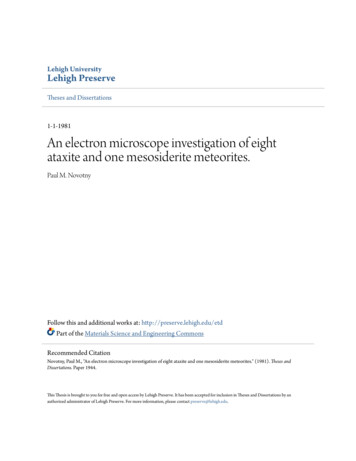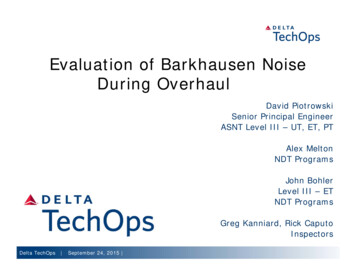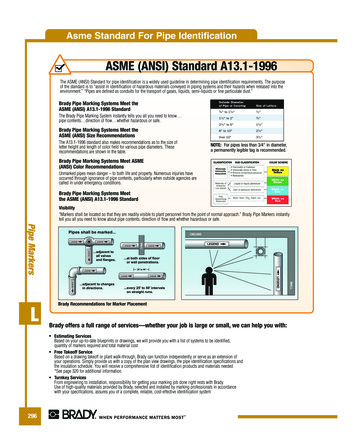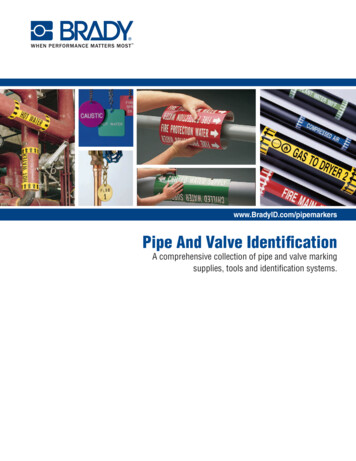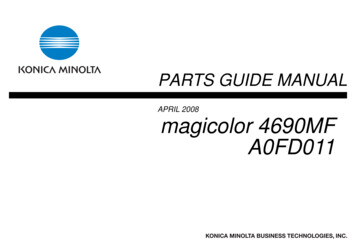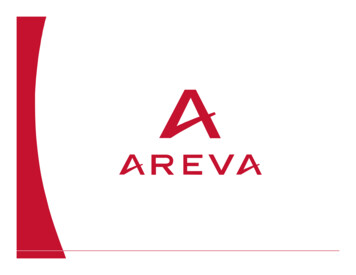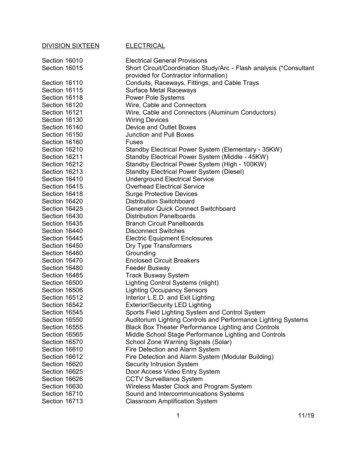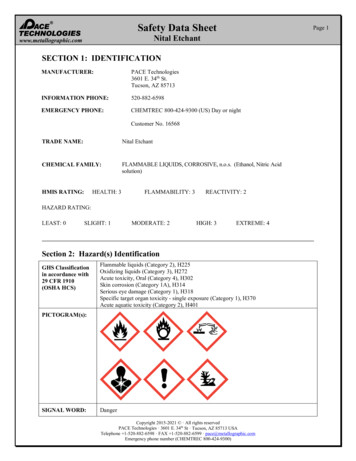
Transcription
Safety Data SheetPage 1Nital EtchantSECTION 1: IDENTIFICATIONMANUFACTURER:PACE Technologies3601 E. 34th St.Tucson, AZ 85713INFORMATION PHONE:520-882-6598EMERGENCY PHONE:CHEMTREC 800-424-9300 (US) Day or nightCustomer No. 16568TRADE NAME:Nital EtchantCHEMICAL FAMILY:FLAMMABLE LIQUIDS, CORROSIVE, n.o.s. (Ethanol, Nitric Acidsolution)HMIS RATING:HEALTH: 3FLAMMABILITY: 3REACTIVITY: 2HAZARD RATING:LEAST: 0SLIGHT: 1MODERATE: 2HIGH: 3EXTREME: 4Section 2: Hazard(s) IdentificationGHS Classificationin accordance with29 CFR 1910(OSHA HCS)Flammable liquids (Category 2), H225Oxidizing liquids (Category 3), H272Acute toxicity, Oral (Category 4), H302Skin corrosion (Category 1A), H314Serious eye damage (Category 1), H318Specific target organ toxicity - single exposure (Category 1), H370Acute aquatic toxicity (Category 2), H401PICTOGRAM(s):SIGNAL WORD:DangerCopyright 2015-2021 · All rights reservedPACE Technologies · 3601 E. 34th St · Tucson, AZ 85713 USATelephone 1-520-882-6598 · FAX 1-520-882-6599 · pace@metallographic.comEmergency phone number (CHEMTREC 800-424-9300)
Safety Data SheetNital zard Statement(s):H225- Highly Flammable liquid and vaporH272 - May intensify fire; oxidizerH302- Harmful if swallowedH314- Causes severe skin burns and eye damageH318 - Causes serious eye damageH370- Causes damage to organsH401- Toxic to aquatic lifePrecautionary Statement(s):Preventions:P210- Keep away from heat/sparks/open flames/hot surfaces. — No smoking.P220- Keep/Store away from clothing and combustible materials. P221- Take anyprecaution to avoid mixing with combustibles, strong bases, metallic powders, carbides,hydrogen sulfide, turpentine, and combustible organics.P221- Take any precaution to avoid mixing with combustiblesP233- Keep container tightly closed.P240- Ground/bond container and receiving equipment.P241- Use explosion-proof electrical/ventilating/lighting equipment.P242- Use only non-sparking tools.P243- Take precautionary measures against static discharge.P260- Do not breathe dust/fume/gas/mist/vapors/spray.P264- Wash hands thoroughly after handling.P270- Do not eat, drink or smoke when using this product.P273- Avoid release to the environment.P280- Wear protective gloves/protective clothing/eye protection/face protection.Response:P301 P312: IF SWALLOWED: call a POISON CENTER or doctor/physician IF you feelunwell.P303 P361 P353- IF ON SKIN (or hair): Remove/Take off Immediately all contaminatedclothing. Rinse SKIN with water/shower.P304 P340- IF INHALED: Remove victim to fresh air and Keep at rest in a positioncomfortable for breathing.P305 -P351 P338- IF IN EYES: Rinse cautiously with water for several minutes. Removecontact lenses, if present and easy to do. Continue rinsing.P307 P311P310- IF INHALED: Remove victim to fresh air and Keep at rest in a position comfortablefor breathing.P312- Call a POISON CENTER or doctor/physician if you feel unwell.P321- Specific treatment (see Section 4 SDS).P330-P363- Wash contaminated clothing before reuse.P363- Avoid release to the environment.P370 P378- In case of fire: Use dry sand, dry chemical or alcohol-resistant foam forextinction.Storage:P403 P235- Store in a well-ventilated place. Keep cool.P405- Store locked up.Disposal:P501- Dispose of contents/container to Federal, State and Local Regulations.Copyright 2015-2021 · All rights reservedPACE Technologies · 3601 E. 34th St · Tucson, AZ 85713 USATelephone 1-520-882-6598 · FAX 1-520-882-6599 · pace@metallographic.comEmergency phone number (CHEMTREC 800-424-9300)Page 2
Safety Data SheetNital EtchantEmergency Overview-------------------------POISON! DANGER! CORROSIVE. LIQUID AND MIST CAUSE SEVEREBURNS TO ALL BODY TISSUE. OXIDIZER. CONTACT WITH OTHERMATERIAL MAY CAUSE FIRE. MAY BE FATAL IF SWALLOWED.HARMFUL IF INHALED. INHALATION MAY CAUSE LUNG ANDTOOTH DAMAGE. MAY BE FATAL IF SWALLOWED. HARMFUL IFINHALED OR ABSORBED THROUGH SKIN. VAPOR HARMFUL.FLAMMABLE! AFFECTS CENTRAL NERVOUS SYSTEM. MAY CAUSEBLINDNESS. CANNOT BE MADE NONPOISONOUS. CAUSESIRRITATION TO SKIN, EYES AND RESPIRATORY TRACT. MAYAFFECT LIVER, BLOOD, REPRODUCTIVE SYSTEM. lth Rating: 3 - Severe (Poison)Flammability Rating: 3 - Severe (Flammable)Reactivity Rating: 2 - ModerateContact Rating: 4 - Extreme (Corrosive and Life)Lab Protective Equip: GOGGLES & SHIELD; LAB COAT & APRON; VENTHOOD; PROPER GLOVES; CLASS B EXTINGUISHERStorage Color Code: White (Corrosive) and Red ---------Potential Health Effects---------------------------------Nitric acid is extremely hazardous; it is corrosive, reactive, an oxidizer, and apoison.Inhalation:Corrosive! May cause irritation of the nose, throat, and respiratory tract includingcoughing and choking. Higher concentrations or prolonged exposure to vapors ofnitric acid may lead to pneumonia or pulmonary edema.Ingestion:Corrosive. May cause immediate pain and burns of the mouth, throat, esophagusand gastrointestinal tract.Skin Contact:Corrosive! May cause redness, pain, and severe skin burns.Eye Contact:Corrosive! Vapors are irritating and may cause damage to the eyes. Contact maycause severe burns and permanent eye damage.Chronic Exposure:Long-term exposure to concentrated vapors may cause erosion of teeth. Longterm exposures seldom occur due to the corrosive properties of the acid.Prolonged skin contact causes drying and cracking of skin. May affect thenervous system. May affect liver, blood, reproductive system. Continuedingestion of small amounts could result in blindnessCopyright 2015-2021 · All rights reservedPACE Technologies · 3601 E. 34th St · Tucson, AZ 85713 USATelephone 1-520-882-6598 · FAX 1-520-882-6599 · pace@metallographic.comEmergency phone number (CHEMTREC 800-424-9300)Page 3
Safety Data SheetPage 4Nital Etchanteye problems or impaired liver or kidney functionAggravation of Pre-existing Conditions:Persons with pre-existing skin disorders, eye disease, impaired liver, kidneyfunction or cardiopulmonary diseases may be more susceptible to the effects ofthis substance.Section 3: Composition/Information on IngredientsHAZARD INGREDIENTSCHEMICALCAS NUMBER% PRESENTHazardousEthyl Alcohol64-17-585-98%YesMethyl Alcohol67-56-11 - 5%YesIsopropyl Alcohol67-63-01 - 5%Yes7697-37-21 - 8%YesNitric AcidSection 4: First-Aid MeasuresImmediate first aid treatment reduces the health effects of this substance.Inhalation:Remove to fresh air. If not breathing, give artificial respiration. If breathing isdifficult, give oxygen. Call a physician.Ingestion:DO NOT INDUCE VOMITING! Give large quantities of water or milk ifavailable. Never give anything by mouth to an unconscious person. Get medicalattention immediately.Skin Contact:In case of contact, immediately flush skin with plenty of water for at least 15minutes while removing contaminated clothing and shoes. Wash clothing beforereuse. Call a physician.Eye Contact:Immediately flush eyes with plenty of water for at least 15 minutes, lifting lowerand upper eyelids occasionally. Get medical attention immediately.Section 5: Fire-Fighting MeasuresFire:Flash point: 13C (55F) CCAutoignition temperature: 422C (792F)Flammable limits in air % by volume:Copyright 2015-2021 · All rights reservedPACE Technologies · 3601 E. 34th St · Tucson, AZ 85713 USATelephone 1-520-882-6598 · FAX 1-520-882-6599 · pace@metallographic.comEmergency phone number (CHEMTREC 800-424-9300)
Safety Data SheetPage 5Nital Etchantlel: 3.3; uel: 19Flammable liquid and vapor!Dangerous fire hazard when exposed to heat or flame.Explosion:Above flash point, vapor-air mixtures are explosive within flammable limits noted above. Vaporscan flow along surfaces to distant ignition source and flash back. Sealed containers may rupturewhen heated. Sensitive to static discharge.Fire Extinguishing Media:Water spray, dry chemical, alcohol foam, or carbon dioxide. Water may be ineffective.Special Information:In the event of a fire, wear full protective clothing and NIOSH-approved self-contained breathingapparatus with full facepiece operated in the pressure demand or other positive pressure mode.Water spray can be used to extinguish fires and cool fire-exposed containers. Water may be usedto flush spills away from exposures and to dilute spills to non-flammable mixtures.Section 6: Accidental Release MeasuresVentilate area of leak or spill. Remove all sources of ignition. Wear appropriatepersonal protective equipment as specified in Section 8. Isolate hazard area. Keepunnecessary and unprotected personnel from entering. Contain and recover liquidwhen possible. Use non-sparking tools and equipment. Collect liquid in anappropriate container or absorb with an inert material (e. g., vermiculite, dry sand,earth), and place in a chemical waste container. Do not use combustible materials,such as saw dust. Do not flush to sewer! US Regulations (CERCLA) requirereporting spills and releases to soil, water and air in excess of reportablequantities. The toll free number for the US Coast Guard National ResponseCenter is (800) 424-8802.Section 7: Handling and StorageProtect against physical damage. Store in a cool, dry well-ventilated location,away from any area where the fire hazard may be acute. Outside or detachedstorage is preferred. Separate from incompatibles. Containers should be bondedand grounded for transfers to avoid static sparks. Storage and use areas should beNo Smoking areas. Use non-sparking type tools and equipment, includingexplosion proof ventilation. Containers of this material may be hazardous whenempty since they retain product residues (vapors, liquid); observe all warningsand precautions listed for the product.Copyright 2015-2021 · All rights reservedPACE Technologies · 3601 E. 34th St · Tucson, AZ 85713 USATelephone 1-520-882-6598 · FAX 1-520-882-6599 · pace@metallographic.comEmergency phone number (CHEMTREC 800-424-9300)
Safety Data SheetNital EtchantSection 8: Exposure Controls/Personal ProtectionAirborne Exposure Limits:Denatured Alcohol:- OSHA Permissible Exposure Limit (PEL):1000 ppm (TWA) for ethyl alcohol400 ppm (TWA) for isopropyl alcohol200 ppm (TWA) for methyl alcohol- ACGIH Threshold Limit Value (TLV):1000 ppm (TWA), A4 - not classifiable as a human carcinogen for ethyl alcohol200 ppm (TWA), 400 ppm (STEL), A4 - not classifiable as a human carcinogenfor isopropyl alcohol200 ppm (TWA), 250 ppm (STEL) skin, for methyl alcoholFor Nitric Acid:OSHA Permissible Exposure Limit (PEL):2 ppm (TWA)ACGIH Threshold Limit Value (TLV):2 ppm (TWA); 4 ppm (STEL)Ventilation System:A system of local and/or general exhaust is recommended to keep employeeexposures below the Airborne Exposure Limits. Local exhaust ventilation isgenerally preferred because it can control the emissions of the contaminant at itssource, preventing dispersion of it into the general work area. Please refer to theACGIH document, Industrial Ventilation, A Manual of Recommended Practices,most recent edition, for details.Personal Respirators (NIOSH Approved):If the exposure limit is exceeded and engineering controls are not feasible, wear asupplied air, full-facepiece respirator, airlined hood, or full-facepiece selfcontained breathing apparatus. Breathing air quality must meet the requirementsof the OSHA respiratory protection standard (29CFR1910.134). Canister-typerespirators using sorbents are ineffective.Skin Protection:Wear impervious protective clothing, including boots, gloves, lab coat, apron orcoveralls, as appropriate, to prevent skin contact.Eye Protection:Use chemical safety goggles and/or a full face shield where splashing is possible.Maintain eye wash fountain and quick-drench facilities in work area.Copyright 2015-2021 · All rights reservedPACE Technologies · 3601 E. 34th St · Tucson, AZ 85713 USATelephone 1-520-882-6598 · FAX 1-520-882-6599 · pace@metallographic.comEmergency phone number (CHEMTREC 800-424-9300)Page 6
Safety Data SheetNital EtchantSection 9: Physical and Chemical PropertiesAppearance:Clear to pale yellow solution.Odor:Suffocating, acrid with whiskey-like odor.Solubility:No information foundDensity:No information foundpH:No information found.% Volatiles by volume @ 21C (70F):100Boiling Point:78C (172F) (ethanol)Melting Point:-114C (-173F) (ethanol)Vapor Density (Air 1):1.6 (ethanol)Vapor Pressure (mm Hg):40 @ 19C (66F) (ethanol)Evaporation Rate (BuAc 1):ca. 1.4 (CCl4 1) (ethanol)Section 10: Stability and ReactivityStability:Stable under ordinary conditions of use and storage.Hazardous Decomposition Products:Carbon dioxide and carbon monoxide may form along with toxic nitrogen oxidesfumes and hydrogen nitrate when heated to decomposition.Hazardous Polymerization:Will not occur.Incompatibilities:Strong oxidants, silver salts, acid chlorides, alkali metals, metal hydrides,hydrazine, and many other substances. Strong bases, metallic powders, carbides,hydrogen sulfide, turpentine, and combustible organics.Conditions to Avoid:Heat, flames, ignition sources and incompatibles.Copyright 2015-2021 · All rights reservedPACE Technologies · 3601 E. 34th St · Tucson, AZ 85713 USATelephone 1-520-882-6598 · FAX 1-520-882-6599 · pace@metallographic.comEmergency phone number (CHEMTREC 800-424-9300)Page 7
Safety Data SheetPage 8Nital EtchantSection 11: Toxicological InformationFor Nitric Acid: Investigated as a mutagen and reproductive effector.For Denatured Alcohol:Toxicological Data:Ethyl alcohol: oral rat LD50: 7060 mg/kg; inhalation rat LC50: 20,000 ppm/10H;Irritation data, eye, rabbit: 500 mg/24H moderate; Investigated as a tumorigen,mutagen, reproductive effector. Methyl alcohol: oral rat LD50: 5628 mg/kg;inhalation rat LC50: 64000 ppm/4H; skin rabbit LD50: 15800 mg/kg; Irritationdata,skin,rabbit: 20 mg/24H, Moderate; Investigated as a tumorigen, mutagen,reproductive effector
Nital Etchant Page 4 eye problems or impaired liver or kidney function Aggravation of Pre-existing Conditions: Persons with pre-existing skin disorders, eye disease, impaired liver, kidney function or cardiopulmonary diseases may be more susceptible to the effects of this substance. Section 3: Composition/Information on IngredientsFile Size: 452KBPage Count: 11
